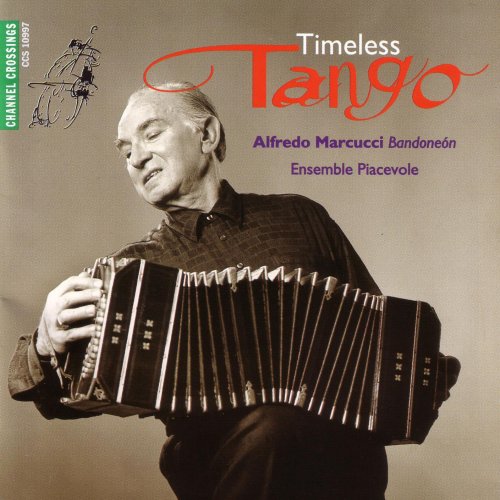
Alfredo Marcucci and Ensemble Piacevole - Timeless Tango (1997)
BAND/ARTIST: Alfredo Marcucci, Ensemble Piacevole
- Title: Timeless Tango
- Year Of Release: 1997
- Label: Channel Classics Records
- Genre: Classical, Latin, Tango
- Quality: FLAC (tracks + booklet)
- Total Time: 1:03:23
- Total Size: 308 MB
- WebSite: Album Preview
Tracklist:
1. Balada Para un Loco (02:47)
2. Oblivion (03:05)
3. La Muerte del Angel (03:34)
4. Aires Españoles (03:19)
5. Melodia en la Menor (04:24)
6. Buenos Aires Hora O (04:15)
7. Tristeza de un Doble A (05:42)
8. Boedo (02:58)
9. Tango (04:37)
10. Ojos Negros (03:59)
11. Selecció de Tangos - Nostalgias / Nieblas del Riachuelo / Los Mareados (03:42)
12. Fuga y Misterio (03:52)
13. Libertango (03:27)
14. Guardia Viega (03:30)
15. Chiquilín de Bachín (03:45)
16. Milonga de Mis Ambres (02:47)
17. Prepárense (03:34)
1. Balada Para un Loco (02:47)
2. Oblivion (03:05)
3. La Muerte del Angel (03:34)
4. Aires Españoles (03:19)
5. Melodia en la Menor (04:24)
6. Buenos Aires Hora O (04:15)
7. Tristeza de un Doble A (05:42)
8. Boedo (02:58)
9. Tango (04:37)
10. Ojos Negros (03:59)
11. Selecció de Tangos - Nostalgias / Nieblas del Riachuelo / Los Mareados (03:42)
12. Fuga y Misterio (03:52)
13. Libertango (03:27)
14. Guardia Viega (03:30)
15. Chiquilín de Bachín (03:45)
16. Milonga de Mis Ambres (02:47)
17. Prepárense (03:34)
Timeless Tango It all seems so ordinary. Behind the front door of a semi-detached house in Belgium, the scent of old-fashioned vegetable soup creeps into the nostrils. The walls in the living room are hung with diligently embroidered panels and friendly family photographs. The paterfamilias shuffles, like an essential prop in the scene, over the warm tile floor. There is more here than meets the eye. Behind the facade which seems to belong to a retired blue collar worker is the emotion and passion of the Argentinian tango.
This is the house of Alfredo Marcucci, a man who imbibed the tango with his mother’s milk, and one whose roots are still anchored in the sung and played tristessa of the Argentinian immigrants. Marcucci first saw the light of day in 1930, in Buenos Aires, center of the tango’s beating heart. Cafes, nightclubs, dance halls, patios, living rooms, every corner of the city was drenched in the melancholy of the Argentinian people, translated into sound. Every evening the numerous competing orchestras stood ready to offer their audiences danceable consolation or steamy oblivion. Any ensemble worthy of the name had four or even five bandoneon players, four violinists, a pianist, a bass player, and two singers who provided a clearly understandable text for the love and grief of the music. In the traditional tango, the singers were the stars of the show. The alternately languorous and biting rhythms and the predictable interludes were only the ground on which the poets could engrave their unhappy loves, unfulfilled desires, and burning homesickness. In this environment, Marcucci succumbed completely to music. At an early age he already had a bandoneon on his lap, the German squeezebox that had been promoted to mouthpiece of Argentina.
This is the house of Alfredo Marcucci, a man who imbibed the tango with his mother’s milk, and one whose roots are still anchored in the sung and played tristessa of the Argentinian immigrants. Marcucci first saw the light of day in 1930, in Buenos Aires, center of the tango’s beating heart. Cafes, nightclubs, dance halls, patios, living rooms, every corner of the city was drenched in the melancholy of the Argentinian people, translated into sound. Every evening the numerous competing orchestras stood ready to offer their audiences danceable consolation or steamy oblivion. Any ensemble worthy of the name had four or even five bandoneon players, four violinists, a pianist, a bass player, and two singers who provided a clearly understandable text for the love and grief of the music. In the traditional tango, the singers were the stars of the show. The alternately languorous and biting rhythms and the predictable interludes were only the ground on which the poets could engrave their unhappy loves, unfulfilled desires, and burning homesickness. In this environment, Marcucci succumbed completely to music. At an early age he already had a bandoneon on his lap, the German squeezebox that had been promoted to mouthpiece of Argentina.
Classical | World | Latin | FLAC / APE
As a ISRA.CLOUD's PREMIUM member you will have the following benefits:
- Unlimited high speed downloads
- Download directly without waiting time
- Unlimited parallel downloads
- Support for download accelerators
- No advertising
- Resume broken downloads


